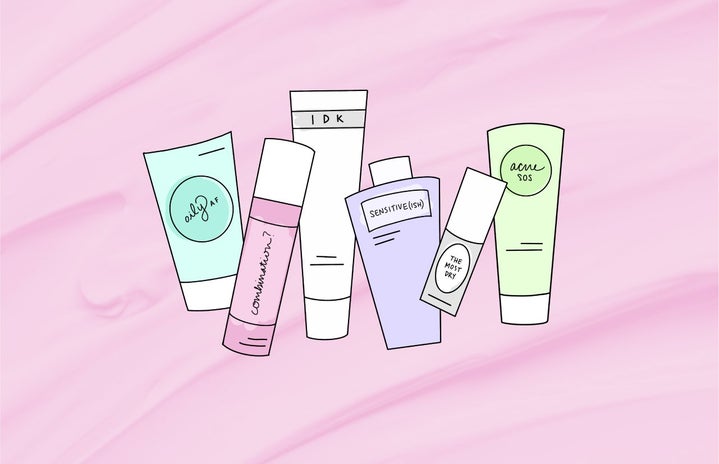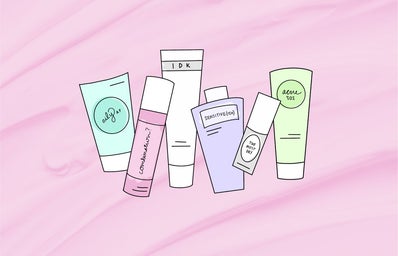In the age of natural-looking “no-makeup makeup” a la Glossier, skincare has become the name of the game. Although seeing those beautiful Instagram flatlays of skincare products may entice you to add a ton of items to your online shopping cart, there’s one important rule to remember: not all skincare products are created equal. What works best for you really depends on your skin type.
Figuring out your skin type is an important first step in creating a skincare routine. The holy-grail products for people with one skin type might irritate or even break out those of another. If this all sounds a little complicated to figure out, don’t stress! Her Campus has all the info on skin types and what works for each one, so that you can find the products that work best for you.
Testing your Type
If you have a general sense of how your skin reacts to the environment and what problems you face on a day-to-day basis, you could double check your skin type with an online quiz (like this one by NIVEA, which is pretty straightforward). If you’re not sure, however, simply head to the bathroom!
Sephora advises that you wash your face, and then let it be without applying moisturizer or any other products for two hours before checking your skin in the mirror. This will reveal your skin’s natural appearance and tendencies toward dryness or oiliness. When the two hours are up, look for these signs and see how your skin reacts to addressing those areas.
Dehydration Station: Dry Skin
If you’re noticing rough, flaky patches on your skin, or a feeling of tightness, itchiness, or overall dryness, you’re going to want to look for products targeted towards dry skin. Note that dry skin can be seasonal, especially if you live somewhere with colder weather.
When it comes to finding products for dry skin, think moisture! That can mean both oil and water. Oil-based cleansers, like this Ultra Facial Cleanser from Kiehl’s ($10-$20), are great on dry skin because you’ll remove the impurities without taking the moisture with them, too. When you do moisturize, opt for a cream with nourishing oils or shea butter, like the Shea Moisture Raw Shea Butter Hydrating Moisturizer ($11), that will help your skin retain that hydration.
Related: What to Emphasize in Your Skincare Routine If You Want to Go Makeup-Free
Shine, Shine, Shine: Oily Skin
If your face is tacky to the touch, and you’re looking or feeling shiny or sweaty (without having exposed yourself to heat/humidity or strenuous exercise during that two-hour wait), you have oily skin. This means you’re going to want to focus on oil control during the day, and avoid oil-based products. Adding more oil to your face will cause it to mix with sebum, your skin’s natural oils, and an excess of oil can clog your pores and lead to breakouts.
Your cleanser should be gentle, and not overly drying. Though it sounds counter-intuitive, going overboard on removing oil will actually train your skin to produce more, so stick to something mild.
You still need to moisturize even if your skin is creating an excess of moisture. Even though it might seem backwards, the only reason your skin is overproducing oil is because it is overcompensating for dryness. Water-based gels or creams are perfect to this end, because the water will counteract the oil you’re over-producing. Try something like the Neutrogena Hydro Boost Water Gel, which is only $7.99 at Target. If you’re looking for more intense skincare, you may consider also adding a gentle exfoliator like Glossier’s Solution ($24) to your routine from time to time, which will help slough away that sebum and unclog your pores before acne forms.
It’s Complicated: Combination Skin
Of course, skin types aren’t always completely clear cut, and maybe you’ve noticed that parts of your face, like the cheeks, are dry and rough, while other parts, generally the T-zone, generate more oil. In this case, you need to find products that work best for combination skin, striking a balance between moisturizing and mattifying without going overboard.
This balance means that you might find mild formulas for cleansers and moisturizers designed to balance out the different areas of your skin. A light, frothy cleanser can help with removing dirt and not drying out the skin; something like the Origins Checks and Balances Frothy Face Wash ($24) will do the trick. Applying a gel moisturizer (see above) afterward can also help you get the water your skin is lacking, and you might want to invest in a hydrating serum like this one from the Ordinary ($7) that will give you an extra boost. For the oilier parts of your face, try a product with mattifying ingredients to keep the shine level down.
Breakouts and Blemishes: Acne-Prone Skin
If the main thing you’re noticing when looking in the mirror is pimples, you’ll want to focus your skincare efforts on targeting those spots. Acne has a myriad of causes, some of which, like hormones and genetics, are unfortunately be out of your control. For acne-prone faces, benzoyl peroxide and salicylic acid are about to become your new best friends. These chemicals are very common and effective in treating acne, but each works a little differently.
Benzoyl peroxide packs a special punch. According to Verywell Health, it’s the most powerful acne treatment you can get without a prescription. It’s sometimes included in cleansers, but you can also apply it as a separate treatment, like this one from Paula’s Choice ($18). It removes excess oil, dead skin cells, and bacteria that cause acne to form on your skin, and it’s especially good for whiteheads or red, enflamed pimples. That said, it’s pretty drying and might not be great for those with sensitive skin.
Salicylic acid is a bit gentler, and also works great on blackheads and bumps on the skin that might not be as outwardly enflamed. It works by dissolving the buildup in your pores to leave your skin feeling smoother. Like benzoyl peroxide, you can often find it in the ingredients list of cleansers or exfoliators, but something like the Mario Badescu Anti Acne Serum ($20) would take a more concentrated approach to your acne.
Smooth Sailing: Normal Skin
If your skin still looks good with no major problem areas after two hours, congrats! Having normal skin, however, doesn’t mean you get a free pass in taking care of your skin; it just means you should focus on maintaining your skin’s health and balance instead of correcting a specific skincare problem.
Opt for a foaming or gel cleanser, like Glossier’s famous Milky Jelly Cleanser ($9+). You’ll want to avoid using an exfoliating cleanser too often (definitely not every day!) because it can irritate the skin. When selecting a moisturizer, you can stick to a lightweight formula for hydration.
Figuring out your skin type is an easy enough process, and once you know the basics, you can narrow down your search for the skincare products that will work best for you. Whether you’re in dire need of extra hydration, or want to get rid of those pesky zits, there’s a product made just for your skin that will help you achieve the clear, smooth skin of your dreams.


